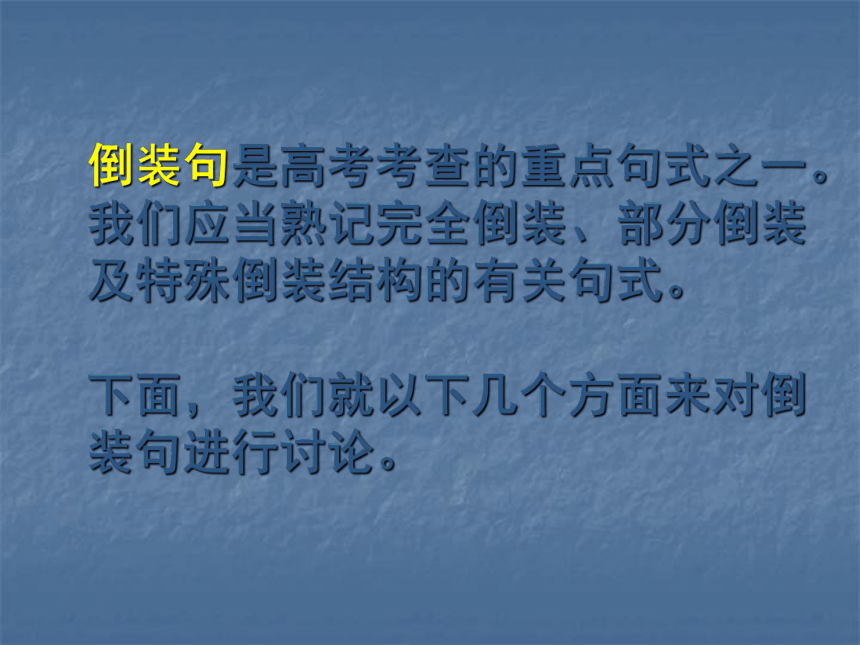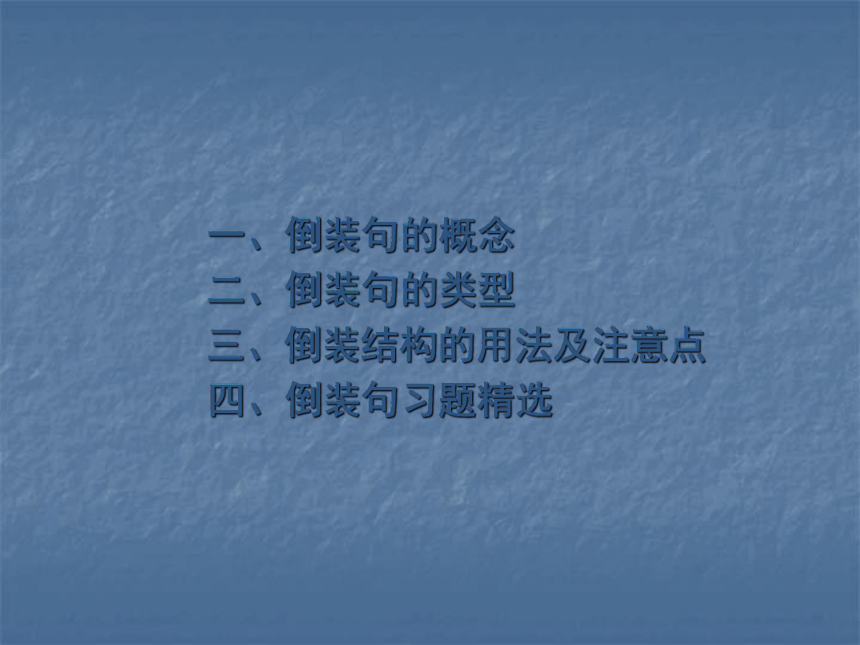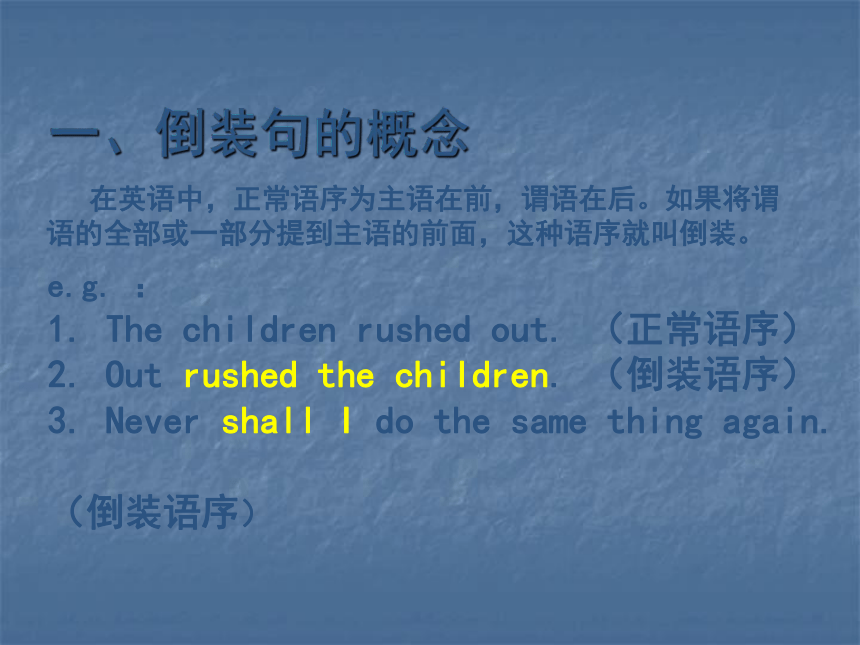英语2011届高考复习课件:倒装句
文档属性
| 名称 | 英语2011届高考复习课件:倒装句 |  | |
| 格式 | rar | ||
| 文件大小 | 202.4KB | ||
| 资源类型 | 教案 | ||
| 版本资源 | 牛津译林版 | ||
| 科目 | 英语 | ||
| 更新时间 | 2010-10-17 11:11:00 | ||
图片预览







文档简介
课件17张PPT。特殊句式— 倒装句倒装句是高考考查的重点句式之一。我们应当熟记完全倒装、部分倒装及特殊倒装结构的有关句式。 下面,我们就以下几个方面来对倒装句进行讨论。一、倒装句的概念
二、倒装句的类型
三、倒装结构的用法及注意点
四、倒装句习题精选一、倒装句的概念 在英语中,正常语序为主语在前,谓语在后。如果将谓语的全部或一部分提到主语的前面,这种语序就叫倒装。e.g. :
1. The children rushed out. (正常语序)
2. Out rushed the children. (倒装语序)
3. Never shall I do the same thing again.
(倒装语序)二、倒装句的类型e.g. (1) In came the boy.
(2) Away flew the bird. 注:1.完全倒装句中的主语一般是名词,而不是代词。
2.完全倒装句通常只用一般现在时和一般过去时。
e.g. (1) At the foot of the mountain lies a village.(完全倒装)
(名词) (一般现在时)
(2) Here you are. (不倒装)
(代词)二、倒装句的类型 1.完全倒装 完全倒装是指当某一特定的内容出现在句首时,将谓语动词直接提前放在主语之前构成的倒装句型。e.g.(1)Only then did we realize that
the man was blind.
(2) Little did he realize that we
were in danger.3. 特殊倒装结构(详见后)2.部分倒装 部分倒装是指当某一特定内容出现在句首时,不能将谓语动词直接提至主语前面,而须将谓语的一部分(如助动词、连系动词be、情态动词等)放在主语前面。三、倒装结构的用法及注意点1、完全倒装 (1)一般疑问句句型(主系表结构)
e.g. Is Mary a teacher?
(2) 特殊疑问句句型(主系表结构)
e.g. Who is that man ?
(3) There be 句型(除be之外,能与there 连用的动词还有
seem, exist, happen, appear , live, stand等)
e.g. ① There are 50 students in the class.
② There stands a tall tree in front of the house.
三、倒装结构的用法及注意点 1、完全倒装(将主语和谓语完全交换位置) (5)当副词here, there, up, down, out, off,
back, in , now, then, away等位于句首,
且主语为名词时,用完全倒装。e.g. ① Near the river was a pine tree.
②In the house lives an old man . 注:这个句型中谓语动词大多为be, sit,
live, lie, stand, rise, go , come 等。 e.g. ① There goes the bell.
② Now comes the bus.(4)表示地点、方向等的介词短语位于句首, 且主语为名词时,用完全倒装(7)表示感叹、祝愿的句子
e.g. ① Gone are the days when they could do what
they liked to the Chinese people.
② Present at the meeting were some scientists
from China. e.g. ① Isn’t it interesting! 真有趣!
② May you succeed! 祝您成功!
③ Long live the people! 人民万岁!(6)当句子中作表语的形容词、过去分词等较短,而主语相对比较长,为了保持句子平衡而将表语前置时,句子的主谓语也应完全倒装。(8) 直接引语的一部分或全部位于句首,主句用完
全倒装
(9) 为使上下文紧密衔接,可用完全倒装
e.g. “ You’d better do it at once”, said his mother.
注: 这种用法中常用谓语动词为say, think, ask, cry等。 e.g. We saw a house over there, in front of which
stood an apple tree.
我们看见那边有一所房子, 房子前边有一棵苹果树。 2.部分倒装 (1)一般疑问句句式(主谓宾结构)
e.g. Did he tell you the news yesterday?
(2)特殊疑问句句型(主谓宾结构)
e.g. Why can’t I smoke here? (3)否定词或半否定词, 如never, seldom, hardly, rarely,
not, nor, neither, little, scarcely, not until,
nowhere, not only, nothing, no sooner(…than),
at no time, by no means, on no condition,
in no case等位于句首时,用部分倒装。 2.部分倒装(只将谓语动词的一部分,如助动词,连系动词 be,情态动词等放在句首)e.g. ① Never have I seen such a performance.
② Little does he realize the danger he is in.
③ Not only will help be given to the people to find jobs, but also medical treatment will be provided for the people who need it.
不但会帮助人们找工作,还会为那些需要的人提供医疗。 注:1. Hardly (Scarcely)…when, no sooner… than,
not only…but also等引导两个分句时,
前一个分句用部分倒装,后一个分句不倒装。
e.g. Hardly had he begun to speak when his father
stopped him.
2.neither…nor引导两个分句时,两个分句都要倒装。 e.g. Neither do I know it, nor does she.
3.not until …放在句首,如果until后面跟的是一个从句,
从句不要用倒装,主句要用部分倒装。 e.g. Not until his father came back did he begin to
to do his homework.e.g. ① Only in this way can you help her.
② Only then did we realize that the man
was blind.注:1.当only 后面跟的状语是一个从句时,从句不倒装,
主句用部分倒装。
e.g. Only when you have grown up can you understand
your parents.
2.only 放在句首,但不修饰状语时,用正常语序。
e.g. Only I can go there.(4) only修饰副词、介词短语或状语位于句首时, 用部分倒装 e.g. ① ——My room gets very cold at night.
——So does mine.
② I don’t like football. Neither does he.
注:如果句意表示肯定或附和 “的确如此”时,句子不用倒装
e.g. —— It’s hot.
—— So it is.(的确如此)(5) so(也), neither, nor(也不)放在句首时, 用部分倒装3.特殊倒装结构e.g.
①Terrible as the storm was, we continued our way.
尽管暴风雪很大,但我们还是继续赶路。
②Child as he was, he was able to stand on his own feet.
尽管他是个孩子,他已经能够独立地生活了。
③Try as she might, Carolina couldn’t get the door open.
尽管卡罗琳娜尝试了,但还是打不开门。
注:1.这种句型中,as后面仍然跟陈述句语序,不用倒装。
2.表语部分如有冠词,要将其省略。3.特殊倒装结构 (1) as(尽管)引导让步状语从句时,通常将句中 状语、表语部分或动词提前,如果表语是名词,其前 不加冠词。e.g.① If you had come here , you would have met
the film star.
→Had you come here, you would have met the film star.
你当时要是来这里的话,就能见到那位电影明星了。② If I were you , I would take up art.
→ Were I you , I would take up art.③If Mary should call, please tell her that
I’ll be back in an hour.
→Should Mary call, please tell her that
I’ll be back in an hour.(2)在if引导的虚拟条件句中,如果从句的谓语动词 部分含有were, had, should等,可以将这些词提 至句首,并且if省略,从句构成特殊倒装结构。Thank you
二、倒装句的类型
三、倒装结构的用法及注意点
四、倒装句习题精选一、倒装句的概念 在英语中,正常语序为主语在前,谓语在后。如果将谓语的全部或一部分提到主语的前面,这种语序就叫倒装。e.g. :
1. The children rushed out. (正常语序)
2. Out rushed the children. (倒装语序)
3. Never shall I do the same thing again.
(倒装语序)二、倒装句的类型e.g. (1) In came the boy.
(2) Away flew the bird. 注:1.完全倒装句中的主语一般是名词,而不是代词。
2.完全倒装句通常只用一般现在时和一般过去时。
e.g. (1) At the foot of the mountain lies a village.(完全倒装)
(名词) (一般现在时)
(2) Here you are. (不倒装)
(代词)二、倒装句的类型 1.完全倒装 完全倒装是指当某一特定的内容出现在句首时,将谓语动词直接提前放在主语之前构成的倒装句型。e.g.(1)Only then did we realize that
the man was blind.
(2) Little did he realize that we
were in danger.3. 特殊倒装结构(详见后)2.部分倒装 部分倒装是指当某一特定内容出现在句首时,不能将谓语动词直接提至主语前面,而须将谓语的一部分(如助动词、连系动词be、情态动词等)放在主语前面。三、倒装结构的用法及注意点1、完全倒装 (1)一般疑问句句型(主系表结构)
e.g. Is Mary a teacher?
(2) 特殊疑问句句型(主系表结构)
e.g. Who is that man ?
(3) There be 句型(除be之外,能与there 连用的动词还有
seem, exist, happen, appear , live, stand等)
e.g. ① There are 50 students in the class.
② There stands a tall tree in front of the house.
三、倒装结构的用法及注意点 1、完全倒装(将主语和谓语完全交换位置) (5)当副词here, there, up, down, out, off,
back, in , now, then, away等位于句首,
且主语为名词时,用完全倒装。e.g. ① Near the river was a pine tree.
②In the house lives an old man . 注:这个句型中谓语动词大多为be, sit,
live, lie, stand, rise, go , come 等。 e.g. ① There goes the bell.
② Now comes the bus.(4)表示地点、方向等的介词短语位于句首, 且主语为名词时,用完全倒装(7)表示感叹、祝愿的句子
e.g. ① Gone are the days when they could do what
they liked to the Chinese people.
② Present at the meeting were some scientists
from China. e.g. ① Isn’t it interesting! 真有趣!
② May you succeed! 祝您成功!
③ Long live the people! 人民万岁!(6)当句子中作表语的形容词、过去分词等较短,而主语相对比较长,为了保持句子平衡而将表语前置时,句子的主谓语也应完全倒装。(8) 直接引语的一部分或全部位于句首,主句用完
全倒装
(9) 为使上下文紧密衔接,可用完全倒装
e.g. “ You’d better do it at once”, said his mother.
注: 这种用法中常用谓语动词为say, think, ask, cry等。 e.g. We saw a house over there, in front of which
stood an apple tree.
我们看见那边有一所房子, 房子前边有一棵苹果树。 2.部分倒装 (1)一般疑问句句式(主谓宾结构)
e.g. Did he tell you the news yesterday?
(2)特殊疑问句句型(主谓宾结构)
e.g. Why can’t I smoke here? (3)否定词或半否定词, 如never, seldom, hardly, rarely,
not, nor, neither, little, scarcely, not until,
nowhere, not only, nothing, no sooner(…than),
at no time, by no means, on no condition,
in no case等位于句首时,用部分倒装。 2.部分倒装(只将谓语动词的一部分,如助动词,连系动词 be,情态动词等放在句首)e.g. ① Never have I seen such a performance.
② Little does he realize the danger he is in.
③ Not only will help be given to the people to find jobs, but also medical treatment will be provided for the people who need it.
不但会帮助人们找工作,还会为那些需要的人提供医疗。 注:1. Hardly (Scarcely)…when, no sooner… than,
not only…but also等引导两个分句时,
前一个分句用部分倒装,后一个分句不倒装。
e.g. Hardly had he begun to speak when his father
stopped him.
2.neither…nor引导两个分句时,两个分句都要倒装。 e.g. Neither do I know it, nor does she.
3.not until …放在句首,如果until后面跟的是一个从句,
从句不要用倒装,主句要用部分倒装。 e.g. Not until his father came back did he begin to
to do his homework.e.g. ① Only in this way can you help her.
② Only then did we realize that the man
was blind.注:1.当only 后面跟的状语是一个从句时,从句不倒装,
主句用部分倒装。
e.g. Only when you have grown up can you understand
your parents.
2.only 放在句首,但不修饰状语时,用正常语序。
e.g. Only I can go there.(4) only修饰副词、介词短语或状语位于句首时, 用部分倒装 e.g. ① ——My room gets very cold at night.
——So does mine.
② I don’t like football. Neither does he.
注:如果句意表示肯定或附和 “的确如此”时,句子不用倒装
e.g. —— It’s hot.
—— So it is.(的确如此)(5) so(也), neither, nor(也不)放在句首时, 用部分倒装3.特殊倒装结构e.g.
①Terrible as the storm was, we continued our way.
尽管暴风雪很大,但我们还是继续赶路。
②Child as he was, he was able to stand on his own feet.
尽管他是个孩子,他已经能够独立地生活了。
③Try as she might, Carolina couldn’t get the door open.
尽管卡罗琳娜尝试了,但还是打不开门。
注:1.这种句型中,as后面仍然跟陈述句语序,不用倒装。
2.表语部分如有冠词,要将其省略。3.特殊倒装结构 (1) as(尽管)引导让步状语从句时,通常将句中 状语、表语部分或动词提前,如果表语是名词,其前 不加冠词。e.g.① If you had come here , you would have met
the film star.
→Had you come here, you would have met the film star.
你当时要是来这里的话,就能见到那位电影明星了。② If I were you , I would take up art.
→ Were I you , I would take up art.③If Mary should call, please tell her that
I’ll be back in an hour.
→Should Mary call, please tell her that
I’ll be back in an hour.(2)在if引导的虚拟条件句中,如果从句的谓语动词 部分含有were, had, should等,可以将这些词提 至句首,并且if省略,从句构成特殊倒装结构。Thank you
